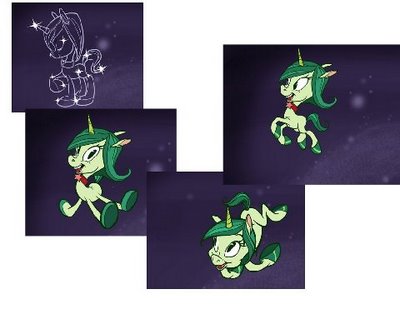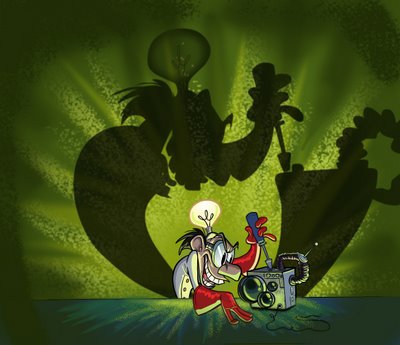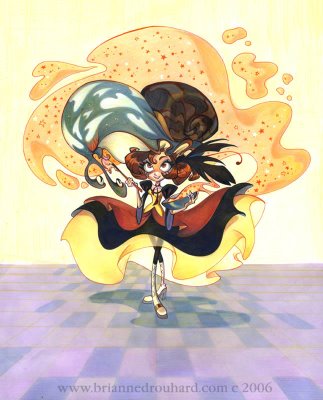I repeat: It doesn't do you any good to say you have a lot of influences if you don't put them to tangible use.
I see a lot of people eagerly jumping in and agreeing with how important it is to have a lot of influences, then I click the links to some of their blogs and see that while they may believe they have influences, the art doesn't show a bit of it.
You can't be influenced in any useful way if you have no discernible drawing skills. First you have to get to the point where you can just draw basic principles, before you can start to absorb and use, say... Chuck Jones' personal stylistic flourishes.
What almost all the people I admire have in common is that they have high levels of skills. Then on top of that, they use their skills to express their own ideas and personal quirks and styles.
Now most people today have little or no skill. Why? This is an era of amateurism. The whole idea of skill is a concept from the distant past. There are no schools teaching basic functional skills. There is no general high standard in the arts to look up to that you could at least reach up for or be embarrassed by your lack of the general level of skill in professional art.
The most skilled artists today can't touch the average skills of artists from 1940. The best modern Disney animators are shadows of the masters they look up to. I'm a shadow of Bob McKimson and Rod Scribner. The few of us who have any skills at all are completely bucking the system and having to flounder around and get through sheer talent and trial and error and searching the past. There is no one around to help us.
Well, I'm helping you and you should take advantage of me. What has taken me decades to rediscover from the past, I am offering you for free. I can save you a lot of time, but I can't make you do the work you need to do to get there. You have to actually draw and copy solid drawings that use basic principles.
David Germain admits in the last post that he is too cocksure to copy anything directly. Look at his art and see the result of his attitude.
Now just for comparison, take a look at the drawings of a 22 year old Canadian lass who went to the crummiest animation school in North America.






What's the difference between these drawings and most of the drawings on the cartoon blogs? They look REAL. Like...professional. Well Jess taught herself to draw like this by watching old cartoons when she was a kid and copying them and trying to figure out what made drawings look real.
She taught herself-with the help of classic cartoons-how to do
Construction
Line Of Action
Sillhouettes
Clear posing
Appeal
A bit of perspective
And on top of that she was doing full animation by the time she was 18! Now Jess is an exceptional case. She absorbs information and things she likes like a sponge. Obviously if everyone had her gifts we wouldn't have crummy amateurish drawings and animation everywhere today like we do.
But everyone doesn't have super human talent. But if you have some talent you can learn this stuff too by following the free lessons I put on this blog.
FREE FOR CHRIST'S SAKE!
http://johnkstuff.blogspot.com/2006/05/animation-school-lesson-1-construction.html
All you have to do is do the work. Copy the Preston Blair drawings EXACTLY. Do the drawings in the order of the steps he tells you to.
Check your mistakes and draw the same drawings again and fix them.
Then, when you start understanding drawing principles, start copying the best drawn classic cartoons.
COPY HIGHLY SKILLED NON-STYLISH CLASSIC ANIMATORS
Copy Bob McKimson in the Clampett or Jones or Avery cartoons.
Copy Tom and Jerry cartoons. This may surprise you because I have mentioned that I find Tom and Jerry boring and bland as entertainment. I do. I can barely sit through them. They are totally generic.
BUT-they are full of good drawing and animation principles and are perfect for learning these principles yourself.
ONCE YOU LEARN BASIC CLASSIC ANIMATION PRINCIPLES, YOU CAN THEN EASILY ADAPT TO ANY OTHER CARTOON STYLE.
Preston Blair is not a style. It's an approach to drawing for art that moves easily and well.
On the other hand, while I find many of Chuck Jones' 50s cartoons infinitely superior in style, thought, craftsmanship, wit and humor to Tom and Jerry, I don't recommend copying or studying those-not until you understand the basics, which will take many of you at least a couple of years of steady concentrated study and practice.
It's too easy to be distracted by all of Chuck's stylistic flourishes that he lays on top of the principles, and you will miss the foundations.
You need to be able to tell the difference between fundamentally good drawing-and style. Everyone today thinks he has a style. You don't. You have to be able to draw before you can have a style, Chet. Even among highly skilled animators and artists, very few have original and unique styles. You can't learn style. You either have it or you don't. It's like personality. I only know one person who actually made up a personality. Don't make up a style. Draw well instead.
Study 40s Chuck Jones and you will learn a lot.
This is why I also why I don't recommend studying 50s or later Disney-it also has many superficial stylistic nuances that distract from the great principles underneath.
Look at the difference between say, Sleeping Beauty and Mulan. Sleeping Beauty is phenomenally well drawn and animated and staged and colored. It's a technical masterpiece. Mulan is just a piece.
The only similarity is that both movies draw sharp corners on the characters. But in Sleeping Beauty, the corners are in consistent and sensible places. In Mulan, they just morph and switch places and warp all over the structureless melting characters.
Classic Disney features are waaaay too sophisticated and difficult to draw to be able to help you learn anything. They also use very specifically Disney type cheesy expressions and you will absorb those, as all the Cal Arts kids too. They absorb the cheese without the solid foundation.
Late 30s and early 40s Donald and Mickey's are good for principles and solid drawing, but they are dangerously sissified, so be careful!
Disney is a very dangerous influence. Those original artists had a ton of serious drawing training and they combined strong principles with vacuous kitschy Walt Disney acting and sappiness. The amazing craftsmanship lures you into thinking that everything they did was right-even the cheesy ideas and sick expressions and sissy movements.
A horrible thing about how ignorant people in the business are today-especially management at the studios, is that when you do learn solid and appealing drawing, sometimes studios will tell you that you have the "Spumco style". That's a danger of being able to draw these days. Executives and art directors think that good drawing is a "style". So learn to draw, then hide it when you apply at the flat or wiggly style studios. A friend of mine today showed me the model sheets for a new show being worked on and it was shocking how amateurish the "designs" were. They had not a single drawing principle, no style whatsoever and they were just purely depressing to look at. There are networks that run tons of stuff that look like mean 10 year olds draw and write them.
If you want to do that kind of stuff, then ignore this blog. There are plenty of suicide inducing jobs out there for you.
But if you truly love old cartoons and wonder in awe how they could be so beautiful and fun and out of this world with magic, then do the simple lessons I put up here. And forget worrying about style.
Once you learn basics, then you can start being influenced by a wider group of artists because then you can actually understand some of what different artists are doing and apply a bit of their tricks.
Here's another supertalented gal. Brianne has lots of skill and a very personal style. She obviously has mixed together a lot of influences and added her own personality to tie it together so well. I hope I get to work with her some day soon! I think the girls are taking over!



